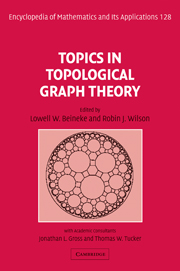Book contents
- Frontmatter
- Contents
- Foreword
- Preface
- Introduction
- 1 Embedding graphs on surfaces
- 2 Maximum genus
- 3 Distribution of embeddings
- 4 Algorithms and obstructions for embeddings
- 5 Graph minors: generalizing Kuratowski's theorem
- 6 Colouring graphs on surfaces
- 7 Crossing numbers
- 8 Representing graphs and maps
- 9 Enumerating coverings
- 10 Symmetric maps
- 11 The genus of a group
- 12 Embeddings and geometries
- 13 Embeddings and designs
- 14 Infinite graphs and planar maps
- 15 Open problems
- Notes on contributors
- Index
Foreword
Published online by Cambridge University Press: 05 June 2012
- Frontmatter
- Contents
- Foreword
- Preface
- Introduction
- 1 Embedding graphs on surfaces
- 2 Maximum genus
- 3 Distribution of embeddings
- 4 Algorithms and obstructions for embeddings
- 5 Graph minors: generalizing Kuratowski's theorem
- 6 Colouring graphs on surfaces
- 7 Crossing numbers
- 8 Representing graphs and maps
- 9 Enumerating coverings
- 10 Symmetric maps
- 11 The genus of a group
- 12 Embeddings and geometries
- 13 Embeddings and designs
- 14 Infinite graphs and planar maps
- 15 Open problems
- Notes on contributors
- Index
Summary
The origins of topological graph theory lie in the 19th century, largely with the four colour problem and its extension to higher-order surfaces – the Heawood map problem. With the explosive growth of topology in the early 20th century, mathematicians like Veblen, Rado and Papakyriakopoulos provided foundational results for understanding surfaces combinatorially and algebraically. Kuratowski, MacLane and Whitney in the 1930s approached the four colour problem as a question about the structure of graphs that can be drawn without edge-crossings in the plane. Kuratowski's theorem characterizing planarity by two obstructions is the most famous, and its generalization to the higher-order surfaces became an influential unsolved problem.
The second half of the 20th century saw the solutions of all three problems: the Heawood map problem by Ringel, Youngs et al. by 1968, the four colour problem by Appel and Haken in 1976, and finally the generalized Kuratowski problem by Robertson and Seymour in the mid-1990s. Each is a landmark of 20th-century mathematics. The Ringel–Youngs work led to an alliance between combinatorics and the algebraic topology of branched coverings. The Appel–Haken work was the first time that a mathematical theorem relied on exhaustive computer calculations. And the Robertson–Seymour work led to their solution of Wagner's conjecture, which provides a breathtaking structure for the collection of all finite graphs, a collection that would seem to have no structure at all.
Each of these problems centres on the question of which graphs can be embedded in which surfaces, with two complementary perspectives – fixing the graph or fixing the surface.
- Type
- Chapter
- Information
- Topics in Topological Graph Theory , pp. xv - xviPublisher: Cambridge University PressPrint publication year: 2009



